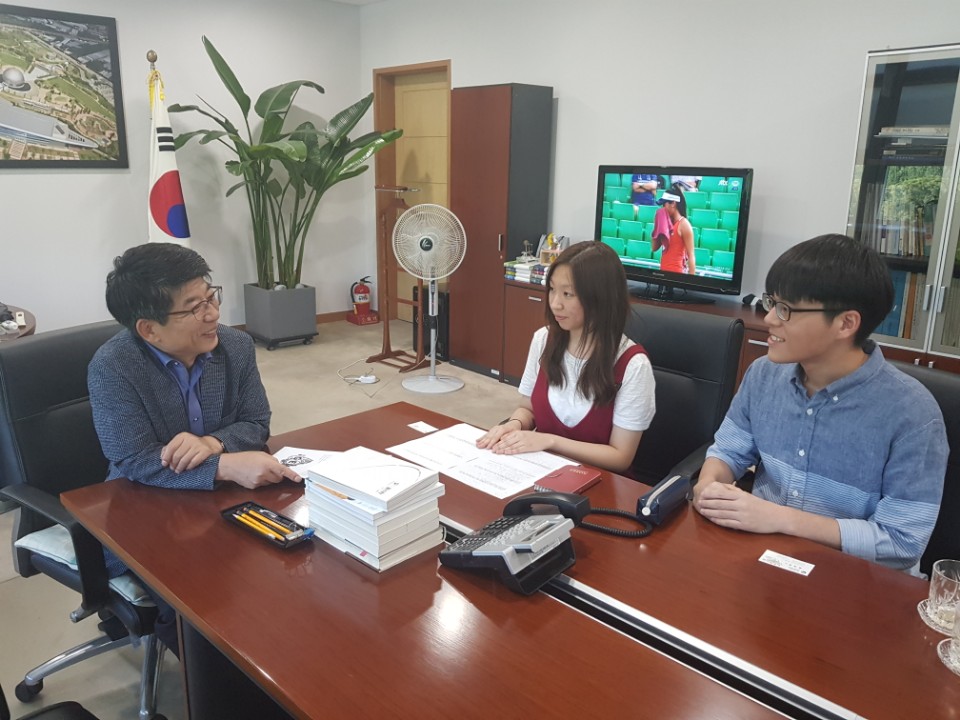Human Practices |
Project application in disease mechanism research
:Korea Centers for Disease Control & Prevention(KCDC)
Our project is about modeling the interactions between different strains of bacteria in a given condition, and its goal is to add more and more factors related to their behaviors and ultimately create a model that accurately depicts their behaviors and interactions in the environment.
Therefore, we were interested in whether concurrent infections, or microbial infections with multiple pathogens involved are commonplace, and if our models could be of any use. To obtain information on current situations and researches in the field, we contacted the Korea Centers for Disease Control & Prevention(KCDC).
We contacted division leader Sungsun Kim and deputy director Sunghan Kim of Bacterial Disease Research division, Center for Infectious Diseases Research in KCDC and conducted an interview regarding the subject.
First of all, simultaneous infection of multiple pathogens are possible, and there are occasional reports of such cases in tick-borne diseases or food-borne diseases. There are also reports of neuraminidases from influenza infections enabling easier invasions of Streptococcus pneumoniae.
However, we received skeptical responses on whether our modeling could be applied to actual cases, since there are numerous factors affecting the infection. In the case of gastro-intestinal infections, for example, the virulence factor between species can differ greatly. Some kinds of bacteria need to amass to millions before causing anything, while others need only tens of microbes to start causing visible symptoms. Furthermore, actual cases vary greatly in both environmental conditions and surrounding biomes. The environment for microbes has enormous differences in different parts of the human body, and the surrounding microbiomes are just as diverse. Finally, some species that cause chronic infections such as tuberculosis can bypass the limitations of growth rates, so although the growth rates of bacteria can be a major index, it does not necessarily represent the infection itself.
In conclusion, we were able to identify a number of factors that need to be added and improved to our model before we can actually utilize it, and we also confirmed the lack of researches and tools in this direction, which calls for additional follow-up researches and improvements on our project.
Project application in Food source assessment and biosafety
:Korea Ministry of Food and Drug Safety (MFDS)
Q&A with Korea Ministry of Food and Drug Safety (MFDS)
KUAS believed that our project could have a positive influence on society in various ways, one of which is the food sector. We wondered how it would be if we put microorganisms in food sources by conducting a study on the relative merits of microorganisms (namely the survival of microorganisms) using evolutionary game theory in the microbial system.
Therefore, we had the following questions in relation to our project, and we proceeded with an email interview with the Korea Ministry of Food and Drug Safety (MFDS) regarding the relevant regulations.
1. Can genetically engineered microorganisms be used as a food source, or a means of production for food sources?
: Intestinal bacteria may cause problems during livestock product safety inspection.
2. In this situation, if a probiotics product genetically engineered to regulate the survival of beneficial bacteria and the reduction of harmful bacteria is developed, what kind of safety inspection would be needed?
We asked Woo Young Jung from the Department of Microorganisms in the MFDS, and we were able to get precise regulations regarding probiotics and genetically engineered microorganisms.
1. Risk assessment (rapid toxicity) is required in order to use microorganism as a food source. There are strong regulations regarding food sources that can be used in food processing, and microorganisms that are not registered are banned.
2. Certain strains may cause disease or resistance to antibiotics, so it may be improper to use them as probiotics.
The following materials are required for risk assessment: Antibiotic Resistance Profile, Production of Antibiotics, Pathogenic Potential, Metabolic Activities, Hemolytic Potential, Side Effects during clinical period. Once the aforementioned data is sent to the MFDS Department of Food Standard, the Committee of Food Hygiene Assessment (which includes professors in related fields, research institutes and industry experts) determines whether or not the product can be listed on the food processing list.
Along with this, we were able to get a food source guide (food source management system handbook) where we found the exact criterion on the possibility of eating microorganisms that we were looking for: “Edibility of microorganisms is evaluated by Common Standard about Food, Food Source Standard, Food Source Assessment Standard. Based on submitted data, food safety is examined. Major submission data is 1) Basic characteristic of the strain (binominal nomenclature) 2) Evidence that is used as source for existing food 3) Data that can prove safety as a food which includes the strain such as animal toxicity test results etc...”
Through this interview with the MFDS, we were able to learn about the application scope and safety standard when extending ‘Evolutionary Game theory in microbial system’ theory to our society. Specifically in this case, it was about the microorganism of the foods that we consume.
Education and exhibition consideration targeting children
:Gwacheon National Science Museum
Introducing synthetic biology to children with the help of the national science museum

Our team visited the National Gwacheon Science Museum. Gwacheon Science museum is one of the widely known children science exhibition center in Korea and greeted its tenth year anniversary this year. We interviewed the Head director of the Gwacheon science museum and requested him an interview. The interview questions mainly dealt the design strategies of exhibition projects and potential of our project to be displayed at the exhibition. From this interview, we tried to seek the possibility of our project as a display for children and how to display it in a safe way.
As our project track is new application and related with evolutionary game theory, we thought that our project could serve as a part of the microorganism theme exhibition that were to be held next year. Therefore, we ought to acknowledge a detailed description on how the exhibition was designed and held. First of all, the theme is decided by the working directors and is discussed with the experts in various fields of science. We learned that the theme should convey an interesting story that could attract many children and adolescents. Furthermore, since most of the audience is children, we should focus on experiential activities instead of delivering difficult information and stir up their interest. Based on the advice, we suggested our project modeling and exhibiting a program that could calculate the survival rate of cooperators and cheaters in animation features. We also came up with ideas of actually displaying the coculturing plate of cheaters and cooperators and obtained information on displaying living microorganisms in a safe way. We thought if we had a guideline for living GMMs, synthetic biology could also be displayed for many people to approach and observe it easily. The director told us they were interested in the project, and may be willing to take this project for the booth in the exhibition that is held next year.
The current exhibition materials related with synthetic biology such as crispr technologies and GMO production through genetic engineering are present at the future technologies section. Despite the displays above, the director told us that new theories or rising fields of science are not willingly introduced in the exhibition, but they always open for many options in the special exhibition section. If Synthetic biology, now a rapidly growing field of science, could be introduced to the new generation through the science museum, it could give the field recognition and special experience to children.
Integrated Practices |
Consulting with the computer modeling and Datamining expert

While seeking for methods to analyze our team’s wet lab data and building significant models, we insisted that there should be further validations to make a more fitting model and its formula. Therefore, we consulted on modeling methods and how to validate our modeling process. Since our project is based on the analyzing of the lab experiment data, we approached this through a top-down method and tried to figure out the formula for the modeling. The problematic situation we faced was having only little data to use as a source of modeling. On this problem, he advised us to approach in a more intuitive manner when modeling in a situation with small data set. The validation method he recommended was hold-out method on history data and use the N fold cross validation. Since our data is especially in small number, he advised us to use the Leave-one out cross validation for better modeling. Furthermore, he claimed that making a sophisticated modeling that perfectly explains the experiment results may not be the most general and all-round modeling. He asserted that we should focus on simplifying the modeling formula via applying the Ockham’s razor so that we could grasp the key signals and exclude the noises.
In addition, upon our opinion of expanding behavior types of the microorganisms, he told us that the modeling would become more sophisticated and we might have to divide cases to visualize into a significant graph. Finally, we asked him about the effectiveness of our research on other fields of studies. Since our experiment condition is very restricted, he explained that our project would only be applicable in certain situations and we should expand the uses by specifying it to certain situations that might require this kind of technique.
Thanks to the interview, we could redress the situation of plateau in the modeling process and find new ways to validate our experiment results which are apparently small in number. Moreover, we insisted that to enlarge the use of our project, we should add certain behaviors that are actually detected in nature and explain the survival rate ratio between different types of microorganisms in coculture environments.
Sponsors




